Epic Guide on Creating the BEST E-Commerce Product Descriptions
If you own an e-commerce store, then you probably already know that product descriptions need to be toward the top of your list of priorities. Product descriptions are used to enhance the customer experience, and they make your site appear more professional. All of this will ultimately work toward your goal of selling more products online.
The Importance of Product Descriptions
When a potential customer lands on your website, they start browsing through your products. Upon doing so, they are probably going to have a bunch of questions pop into their minds as they go through everything you have to offer. For example, if you sell clothing and they are fixated on a particular shirt, they may be wondering how that shirt fits.
If that potential customer browsing through your products can’t find the answers to the questions they have about your merchandise, then they are much more likely to click off your site and look elsewhere. When this happens, you lose your sale.
With better product descriptions, you can not only sell the product the customer is looking at, but you can also find an opportunity there to upsell. You can do this by making it easy for the customer to navigate the site, look at the products, and read the descriptions.
Another important reason you need to work on your product descriptions for an e-commerce store is so you can stand apart from the competition. You are telling your customers that yes, you have the product they are looking for, and no, they won’t find it elsewhere.
The Goal of Product Descriptions
When you create a well-written product description, you are moving the customers through your sales funnel. Along with a photo of your product, you are writing a detailed description and story of that product to help fill in any gaps.
The goal is to explain the products in detail to provide them with a unique value proposition. You are offering a valid solution to a problem, gaining more sales, building customer trust, and even possibly lowering your refund rates because the customers will know exactly what it is they are purchasing after reading a well-written e-commerce product description.
Tips on Creating the Best Product Descriptions
Now that we have covered the importance of writing the best product descriptions, let’s go a bit deeper and learn some tips on how to do this more effectively.
Choose Influential Words
There are a few words that are considered to be more influential than others when it comes to writing your product descriptions. Some of these words include:
- Suddenly
- Announcing
- Introducing
- Amazing
- Sensational
- Revolutionary
- Quick
- Hurry
Along with these more powerful word choices, there are also some you should try to avoid as much as possible. Some of those words to avoid include:
- Market Leading
- Breakthrough
- Innovative
- Ultimate
The word choices need to be honest and accurate. You should also be as transparent as possible when describing your products. You will lose sales if you choose to be deceptive.
However, this doesn’t mean that you have to list all of your product’s weaknesses either. Instead, highlight its strengths and pay close attention to the kind of language you use in the copy.
Don’t Recycle Product Descriptions
The best e-commerce product descriptions are the ones that are unique and different from every other product you are selling. Google is never a fan of any kind of duplicate content when it comes to where you fall in search rankings. Keep all the product descriptions unique for each product, and refrain from ever recycling them.
You also need to write your e-commerce product descriptions to appeal to your intended audience, as well as Google. The descriptions need to make sense to the customer, or they will click away. So, when writing the descriptions, also add in keywords strategically throughout.
It Must Be Grammatically Correct
If you have misspelled words running through your product description, it isn’t going to appear to be very professional. Think about it this way. If you were looking through products and reading the descriptions while stumbling over misspelled words and grammatical errors, what would you do?
Each description needs to be checked two to three times to ensure that there are no spelling errors, everything is grammatically correct, and the description overall makes sense. If not, try again. This is ultimately going to make it or break it with a customer.
Consider Your Target Audience
One of the most important aspects to consider as you write your product descriptions is who you are writing them for. Consider the demographics of your target audience and then use words that are relatable for that specific group of people. For example, if you are targeting an older audience, you want to steer clear of hip and trendy words like lit and Gucci.
After choosing your target audience, keep all of your e-commerce product descriptions consistent. You don’t want to vary the tone throughout. Everything you say in your descriptions will ultimately be portraying your brand.
Don’t Try to Oversell
While you may be excited and eager to talk about how great your products are, you don’t want to go too overboard with this. Yes, it is okay to share the most important information about what you have to offer, but you also want to make sure your customers know how your products can benefit them.
People look to the internet for help finding answers and solutions to questions and problems they have. You want to show these customers that your product is the solution they have been looking for. Tell the story of your product in a way that makes the customer feel as if they already own it, and it is already sitting right next to them.
E-commerce product descriptions are your way of creating a more visual experience for your potential customers. This experience is what will appeal to them and will drive them to purchase your products.
Include Images
When looking for products to purchase, customers want to have a full angle view of what it is they are about to buy. If they do not have an image or multiple images to use, it is harder for them to envision it.
Adding photos or even a short video allows you to show off your product in action, so they can experience everything they need to experience to get them to say yes to your product.
Below you will find an example of a product description from Method. You will find an image to show off the product alongside a very clear description.
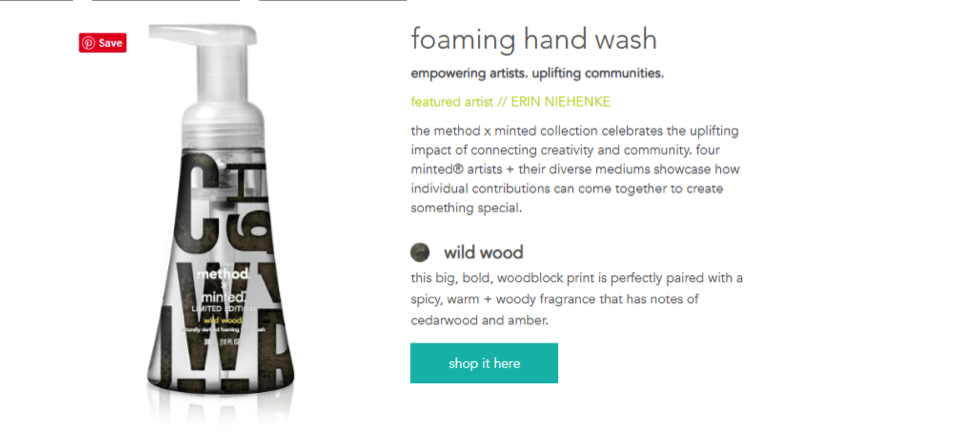 Image Credit: Methodhome.com
Image Credit: Methodhome.com
Don’t Miss Details
Another tip to keep in mind when writing e-commerce product descriptions is making sure you completely explain the product you are selling in detail. Don’t forget to mention what the product is made out of or contains, include any instructions there may be, and any other information the customer may be wondering about.
If your customers still have a lot of questions, even after reading your product description, then it wasn’t written well, and you need to go back and include much more detail.
No Fluff and Filler
Never use any unnecessary words, fluff, or filler when writing out your product descriptions. Overused phrases like good quality, high quality, great design, and ease of use may sound great, but they are also phrases used to describe thousands of other products as well.
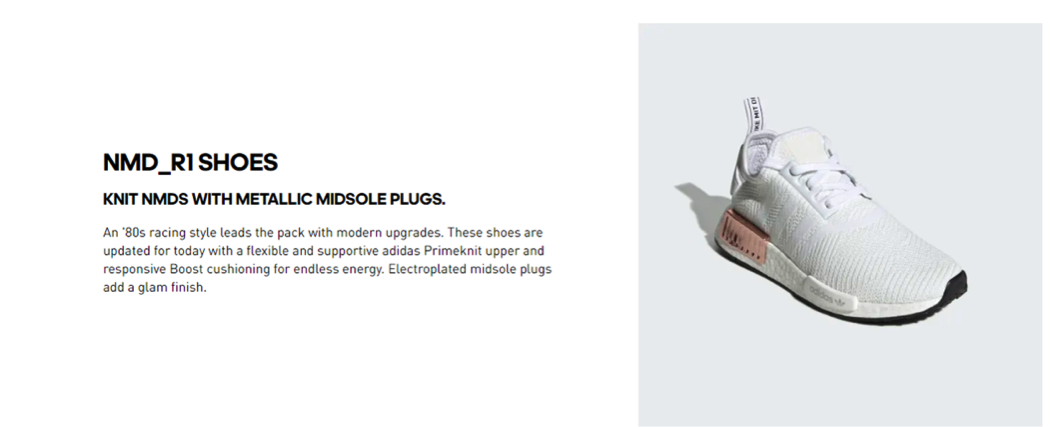 Photo Credit: Adidas.com
Photo Credit: Adidas.com
So, you should really take some time to come up with new and exciting ways to say the same thing, but in a more unique way that will appeal to potential customers. Additionally, the copy must be easy to read and easy to scan.
Look at the example with the Adidas shoes above. Instead of your run of the mill and mundane word choices, they made their product description more exciting by using less commonly used verbiage like endless energy, glam finish, and modern upgrades.
Also, keep in mind that not everyone is going to take the time to read every description word for word. For this reason, it may be beneficial to include a bullet point list of all the key features of your product. That way, they can scan the description, locate the information they were looking for, and have a much better idea about what it is you are offering.
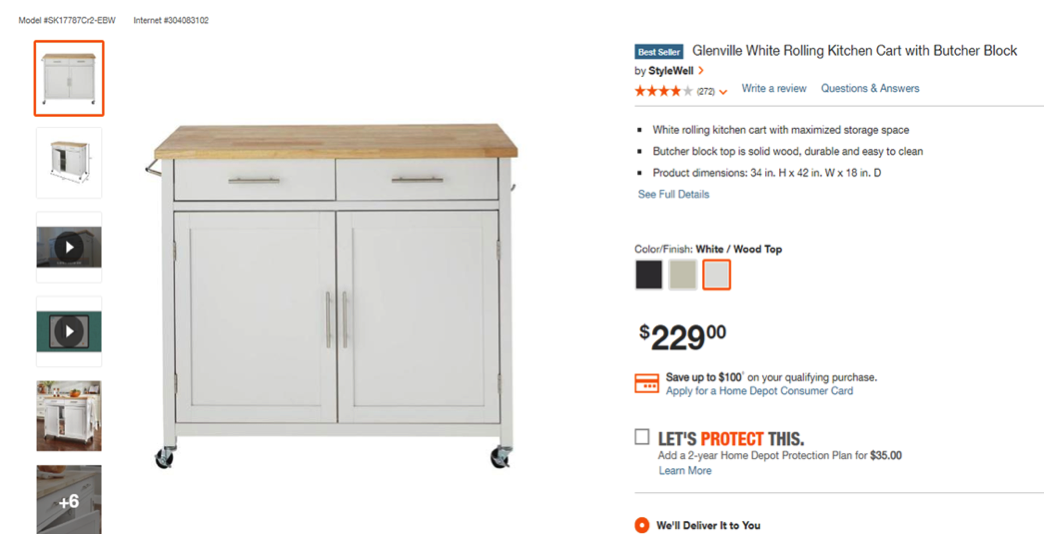
Image Credit: Home Depot
This rolling cart from Home Depot is a good example of how beneficial a bullet point format can be when it comes to quick scanning and readability on the main features of a product.
Highlight the Right Products
If the products you are offering are considered multiuse products, then you will definitely want to use this information and highlight it. When a customer sees more than one possibility for a product, they are more eager to make a purchase.
Writing a good description for these types of products allows you to show your potential customers that they will be getting a great deal.
Provide Social Proof
A lot of the time, people look to the internet for recommendations on products to purchase if they are unsure about what the best product is. If there is a high number of positive reviews, they are more likely to purchase the product. To take advantage of this, there are ways you can use social proof in your product descriptions.
If there is a quote or a review of the product, you can include this in your product description. Adding an image to go with the quote also goes a long way in adding credibility to what you are posting in your description. It is also a great way to make the site more approachable, relatable, and personable.
Reflect Your Brand’s Voice
You should never sway from the voice of your brand when writing your product descriptions. It should sound like it is you talking to someone directly. Now is where you need to decide if you want to take on a more conversational tone or more professional tone with your descriptions.
The Adidas product description above is a good example of a more laid back and conversational tone. They described their shoes but made it fun. In the example below, you will find a product description of a cookware set. It is much more professional and to the point.
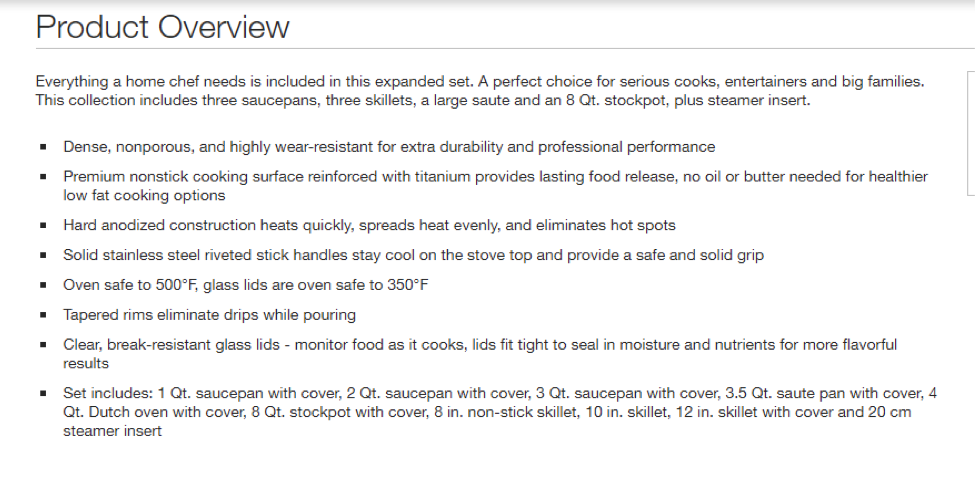 Image Credit: Home Depot
Image Credit: Home Depot
Optimize for Search Engines
No matter what you are selling online, you need to take the time to optimize all of your content for search engines. Search engine optimization (SEO) is one of the easiest ways you can attract and pull in new customers to your website. Once they are on your site, you then have the opportunity to sell them your products.
The first step to optimization is keyword research. Keywords and phrases are what the customer types into the search engines when they are on the hunt for a specific product. If you take the time to perform some keyword research for your site, you will find a list of some of the best keywords to use for your e-commerce site.
To stay in line with SEO best practices, you want to use your keywords in your page titles, meta descriptions, image tags (otherwise known as ALT tags), and product descriptions. While using keywords may not necessarily get you a top-ranking spot on search engines, it will go a long way in making it much easier for potential customers to find your products.
Keyword Research Tips and Tricks
Building the right keyword strategy is important when you build your website and is right up there with your product descriptions. When you have multiple products listed, you need to optimize each page with your keywords.
However, before you can do any of this, you need to first understand what it is potential customers or “buyers” are searching for. Once you have completed this step and you have learned more about your customers and what they are typing in the search bar, you can then begin to hunt down your keywords.
When doing so, find those keywords that align the best with your products without being too broad. Don’t be too generic either because that will present thousands of searches. When you are more specific with your keywords, you are making it easier for the buyer to find your product based on their search.
For example, black dress is too generic. As you can see from the example below, black dress is searched a staggering 9,250,000,000 times. So, be more specific about the black dresses you are selling. Who is the designer? Is it a short dress? Long dress? What occasion is it the ideal dress for?
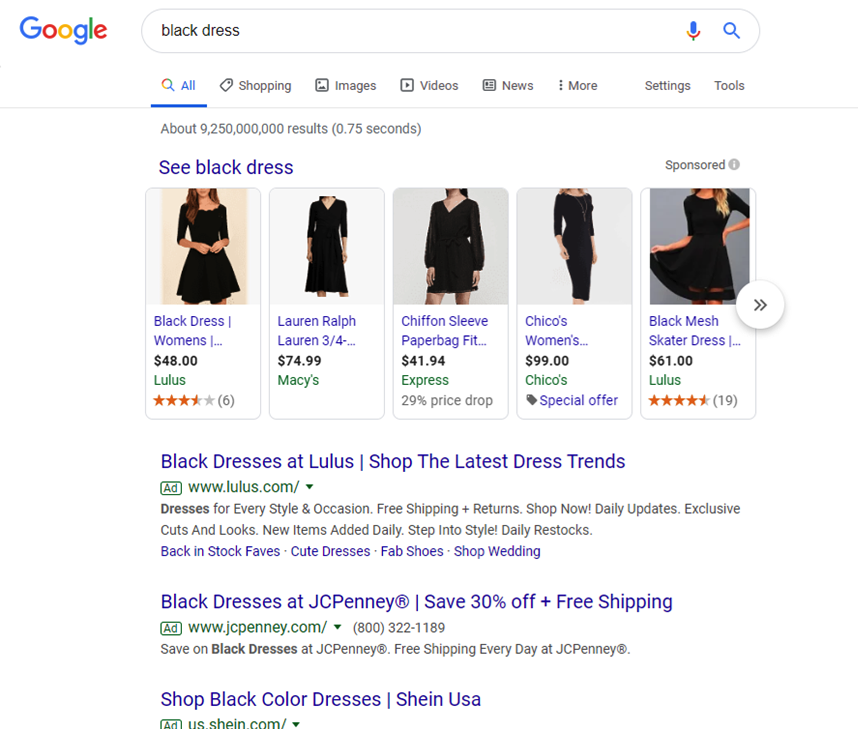 Image Credit: Google
Image Credit: Google
If you need help coming up with keywords or you need more assistance finding out what people are actually searching for, you can use site search tracking in Google Analytics. No matter what, you will most often find more success when you start off with keywords gradually and then build them up over time.
In the meantime, make sure that the keywords you are using for your e-commerce site make sense for your products. If a customer lands on your product page after searching for a specific item but don’t find it on your site, then they will click the back button. When this happens, Google considers it a bounce.
Product Descriptions and PPC
The product ads on Google are called Google Shopping Ads. These are the ads that you see at the top of the results when you are looking for a specific product. Running ads on Google means using the target keywords that you have already chosen for your products and your brand. You can even pay to have your company’s products shown in this way.
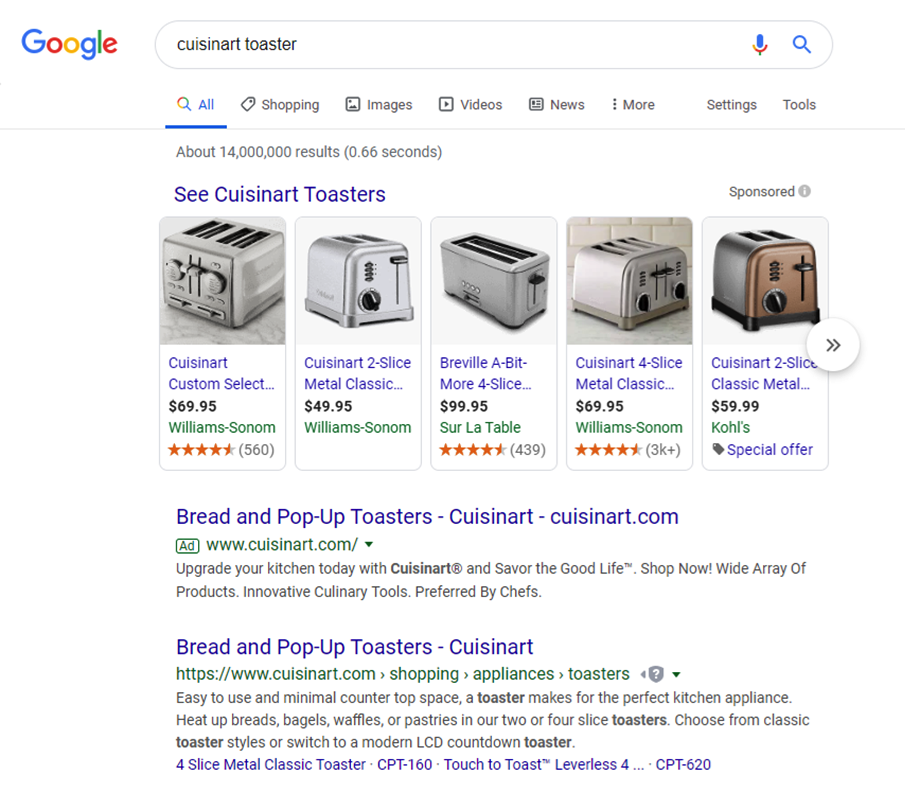 Image Credit: Google
Image Credit: Google
When you choose this option, you don’t have to pay until someone clicks. So, it doesn’t cost you anything to create the ad, but you still want to make sure that your product descriptions are the best they can be – especially because you are ultimately paying for the click to get the sale.
Make sure to include your keywords and optimize your product description to stand apart from the competition. Doing so also allows Google to view your product page as relevant, which ultimately leads to higher Google rankings and more clicks.
Better product descriptions achieve higher click through rates because the customers are finding exactly what it is they are searching for, and most of the time, they had already committed to making a purchase in the first place.
Create a Product Description Template
If you have tried the tips and tricks we mentioned above, but you are still struggling to create the best possible product descriptions for your e-commerce site, then you may want to consider creating your own product description template.
When you attempt to create a template, you need to keep in mind that it isn’t a one size fits all option. You have to consider the criteria that your target audience is searching for when creating any product descriptions, and this can vary.
When creating descriptions, it may be helpful to ask yourself a few questions:
- Is your product solving a problem the buyer currently has?
- What keywords or impact words are you including in your description?
- Did you tell the full story about your product?
- Is this how you would talk to a friend, or is the copy too salesy?
- Did you include an image alongside the key benefits and features of your product?
Answering these questions will help you create your product description template. You can then test those descriptions out and analyze the results. Based on the results, you can then make changes to your descriptions.
Good Product Description Versus Bad
When determining if a product description is good or bad, you aren’t necessarily focusing on the length or the verbiage as much as making sure you have explained the product in detail and have shown why it is your product they should purchase.
If you have a unique product, then you might have to go into more detail to explain what it is and what it does. However, if you have a basic product, like a white t-shirt, for example, people already have a good idea about what it is and its intended use, so the description can remain relatively short and to the point.
A good product description will clearly explain what the product does, express its other added value and benefit, and include all relevant information the customer needs to make a decision.
Some product descriptions go as far as extending their information to other tabs that include the technical specs and answers to questions they may have as you can see from our example below:
 Image Credit: Polaroid
Image Credit: Polaroid
This camera’s description starts with a paragraph that explains what this camera is. Below this description, you can then find more information about the series along with all of its technical specifications, as well.
A good product description eases any uncertainty or doubts a buyer has about purchasing the product. The more information, the better.
Final Thoughts
Creating the best product e-commerce product descriptions doesn’t have to be a frustrating and challenging experience. As long as you can take the time to learn who your potential customers are as well as what exactly it is they are looking for, you can tailor your descriptions to appeal to them.
Additionally, you need to be writing clearly and concisely while also telling the story of your product in full detail. Outline its uses, benefits, and features, address any and all questions the buyer may possibly have, and ease their uncertainties.
Instead of describing your product, you are ultimately defining your market. You are learning as much as you can about your target audience and understanding what their primary goal is along their journey.

